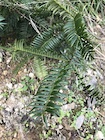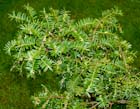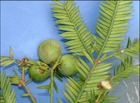Torreya grandis
Fortune ex Lindley 1857
Common names
榧树 fei shu [Chinese], Chinese nutmeg tree (Fu et al. 1999).
Taxonomic notes
There are two varieties:
- Torreya grandis Fortune ex Lindl. var. grandis, syn. T. nucifera (L.) Siebold & Zucc. var. grandis (Fortune ex Lindl.) Pilg. 1903; T. parvifolia T.P. Yi, L. Yang & T.L. Long 2006. Type China, Zhejiang, R. Fortune s.n.
- Torreya grandis Fortune ex Lindl. var. jiulongshanensis Z.Y. Li, Z.C. Tang & N. Kang 1995, syn: T. dapanshanica X.F. Jin, Y.F. Lu & Z.L. Chen 2022. Type China, Zhejiang, Suichang, Jiulong Shan, Z.Y. Li & Z.C. Tang 9009.
Kou et al. (2017) present compelling evidence that T. grandis var. jiulongshanensis is the natural hybrid of T. grandis and T. jackii, based on multiple lines of molecular evidence including nuclear ITS sequences and chloroplast and mitochondrial evidence showing T. jackii as the mother and T. grandis as the father. Moreover, Wang et al. (2019) present evidence of more extensive introgression between T. grandis and T. jackii; see T. jackii for further discussion.
Farjon (2010) reduced T. parvifolia to synonymy with T. grandis var. grandis because the type description, published by Yi et al. in 2006, gave a general description of morphological characters and provided an illustration consistent with the description of T. grandis var. grandis. The publication, only two pages long, is notably sketchy. There has been no subsequent publication dealing with the morphology of T. parvifolia and there is no basis to describe how it may differ from T. grandis, except by inspection of herbarium specimens that are only available in China. Nonetheless, Zhang et al. (2021) have sequenced the chloroplast genome of a single T. parvifolia specimen, and their results place it within a clade shared with T. fargesii, T. nucifera, and T. fargesii var. yunnanensis, and sister to a clade containing T. grandis. Some authors also reduce T. fargesii to synonymy with T. grandis, so although the taxa may be distinct on the basis of the chloroplast genome, the systematic significance of the differences remains unclear. Moreover, T. parvifolia is described from a single population in Sichuan, disjunct from the reported range of T. grandis var. grandis, and grows at substantially higher elevations. It seems possible that T. parvifolia is a distinct taxon, but a useful description of it is still unavailable.
Similarly, T. dapanshanica was described by Lu et al. (2022) as differing from T. grandis var. jiulongshanensis only in a few minor points of morphology and, like var. jiulongshanensis, endemic to a single locality in Zhejiang (Dapanshan National Nature Reserve, at a single locality within the reserve). The description of T. dapanshanica offered no evidence that the possibility of a hybrid origin was considered. Pending further evidence I treat it as synonymous with T. grandis var. jiulongshanensis.
Description
Evergreen trees to 25 m tall and 200 cm dbh, with a broad crown of spreading and ascending branches. Bark irregularly fissured, sometimes flaky, yellow-gray or gray-brown weathering to dark gray. Twigs slender, round, usually with opposite branching, sometimes with more than two laterals from a node, spreading horizontally at 40-70° from the main twig, green turning gray after a year, grooved along decurrent leaf bases. Buds terminal and very small, or at previous year's node and enlarged, broad-triangular, keeled, brown, deciduous. Leaves pectinate, spreading at 65-90° from the shoot, linear, 10-27 × 2-3.5 mm, straight or falcate, with a twisted short petiole, abruptly wider at base, apex cuspidate, coriaceous, lustrous green above, with two stomatal bands on lower surface, 0.3-0.8 mm wide, separated by a midrib and bordered by flat or very narrowly revolute margins; stomata randomly distributed within the band. Pollen cones axillary, solitary, in short rows below lateral twigs, 5-8 × 4.5-5 mm, pale yellow at maturity. Seeds borne in axillary structures, solitary or paired, sessile, the ripe aril fleshy, smooth, purple-brown, often with a whitish bloom, variably ovoid, 25-40 × 12-25 mm (Farjon 2010).
The hybrid, var. jiulongshanensis, has longer leaves (25-45 mm). T. parvifolia is described as a shrubby tree to 5 m tall and 15 cm dbh, with leaves 15-20 × 22-30 mm, apex acute, with seeds 15-20 mm diameter (Farjon 2010, Yi et al. 2006).
Distribution and Ecology
China: Anhui, Fujian, Guizhou, Hunan, Jiangsu, Jiangxi, Zhejiang (var. grandis); and Sichuan if T. parvifolia is included; with var. jiulongshanensis restricted to Jiulong Shan and perhaps Dapan Shan in Zhejiang. Occurs in angiosperm-dominated mixed mesophytic forest at 200-1400 m elevation (2100-2300 m if T. parvifolia is included), typically riparian, sometimes in the canopy (Farjon 2010, Yi et al. 2006).
The IUCN assesses the species and var. grandis as "least concern" due to its wide distribution and relatively stable population. Variety jiulongshanensis has been little studied and is assessed as "data deficient" (Yang and Luscombe 2013). T. parvifolia, if treated as a distinct taxon, has not been assessed but I anticipate that it would qualify as "critically endangered" due to the presence of a only a small number of individuals (approximately 100) in a single population.
Several cultivars are grown in China (Farjon 2010), and it is also planted as an ornamental in Europe and North America (Hils 1993). Hardy to Zone 8 (cold hardiness limit between -12.1°C and -6.7°C) (Bannister and Neuner 2001).
Remarkable Specimens
V. Dinets (Vladimir Dinets e-mail 1998.01.10) reports a tree in Anhui that was 39 m high in 1993.
Chen (2020) has established ages to 90 years. This is the only age, verifiable by reference to a wood sample, that I have located for any species of Torreya. There are, however, plentiful unverified and undocumented claims of trees over 1,000 years old. One specimen is claimed to be 1431 years old, which is even more remarkable as it is a grafted tree. However, the source provides no evidence of this age claim (People's Government of Xiaoxing City 2013), and another source states that the oldest tree was dated to the year 1431, i.e. approximately 600 years old (Chen and Chen 2019).
Ethnobotany
Various cultivars are used as ornamentals in China, North America, and Europe. The decay-resistant wood is desirable for woodworking, used in houses, bridges, and furniture. The seeds are edible and the essential oil "torreya oil" is extracted from the aril. The seeds are used as a cough remedy in Chinese traditional medicine (Farjon 2010), and may in fact confer significant health benefits; Lou et al. (2022) state that the seeds "have been used as food for thousands of years in China due to the attractive aromatic flavor, beneficial nutrients and bioactive compounds. Oils are enriched in seeds of T. grandis with an average content of 45.8%. In all kinds of oils, sciadonic acid (SCA), a non-methylene-interrupted Omega-6 fatty acid, has been found to be enriched in T. grandis, and the content of SCA is over 10% in the kernel oil. SCA has positive effects on human health, and functions in reducing inflammation, lowering triglycerides, preventing blood clots and regulating lipid metabolism."
The history of cultivation of T. grandis for seed harvest is remarkable among conifers worldwide. Although many conifers are cultivated for their seeds, I know of no other species with such a long record of management (extending at least to the late Tang dynasty, which ended in 907 C.E.), or such complex traditional agronomic methods. These trees have been cultivated for centuries, with some cultivated trees having basal diameters of more than 150 cm. Many trees are grafted, with a female tree grafted to a male rootstock, and the trees are planted so as to have female trees clustered around males, to ensure successful pollination while maintaining a strong preponderance of seed-producing trees. Numerous studies have documented this heritage at Kuaijishan in Zhejiang (Bin et al. 2013, Chen and Jin 2019, People's Government of Xiaoxing City 2013, Zhang et al. 2019).
There has been one very basic dendroclimatic analysis performed using 6 stem sections of trees less than 100 years old (Chen 2020).
Observations
No data as of 2023.02.23.
Remarks
The epithet means "large" and may refer to the size of the seed, as does the common name.
Citations
Bin, W., QingWen, M., Bo, D., YanYing, B., Zheng, Y., and YuanTao, X. 2013. Research on ecosystem services value of ancient Torreya grandis in Kuaiji Mountain. Zhongguo Shengtai Nongye Xuebao / Chinese Journal of Eco-Agriculture 21(6):779–785.
Chen, X., and Chen, H. 2019. Dynamics in production of four heritage foods at the mountainous region of Shaoxing City, China. Emirates Journal of Food and Agriculture 31(8):645-653.
Chen, X., and Jin, H. 2019. Review of cultivation and development of Chinese torreya in China. Forests, Trees and Livelihoods 28(1):68–78. doi:10.1080/14728028.2018.1553690.
Chen, Xiongwen. 2020. Historical Radial Growth of Chinese Torreya Trees and Adaptation to Climate Change. Atmosphere 11(7):691. https://doi.org/10.3390/atmos11070691. Open source.
Fu Liguo, Li Nan, and Robert R. Mill. 1999. Taxaceae. In Wu Zheng-yi and Peter H. Raven (eds.). Flora of China, Volume 4. Beijing: Science Press; St. Louis: Missouri Botanical Garden. This document is available online. Go to http://www.efloras.org, click on "Flora of China," and search for the taxon of interest by its scientific name.
Kou, Y.-X., Xiao, K., Lai, X.-R., Wang, Y.-J. and Zhang, Z.-Y. 2017. Natural hybridization between Torreya jackii and T. grandis (Taxaceae) in southeast China. Journal of Systematics and Evolution 55:25-33. https://doi.org/10.1111/jse.12217.
Lindley. 1857. Gardeners' Chronicle and Agricultural Gazette, p. 788. This publication is available online at botanicus.org, and makes a good read, as it contains Fortune's account of how he discovered the species while trekking in the mountains of Zhejiang.
Lou, H., Song, L., Li, X., Chen, W., Gao, Y., Zheng, S., Fei, Z., Sun, X., and Wu, J. 2022. Chromosome-level genome assembly of Torreya grandis provides insights into the origin and evolution of gymnosperm-specific sciadonic acid biosynthesis. bioRxiv. doi:10.1101/2022.10.28.514327.
Lu Y.-F., Chen Z.-L., He A.-G., Liu J.-L., Wang P., Chen W.-J., and Jin X.-F. 2022. Torreya dapanshanica (Taxaceae), a new species of gymnosperm from Zhejiang, East China. PhytoKeys 192:29–36. https://doi.org/10.3897/ phytokeys.192.79506
People’s Government of Xiaoxing City. 2013. Kuaijishan Ancient Chinese Torreya Community. People’s Government of Xiaoxing City. Available: https://www.fao.org/3/bp785e/bp785e.pdf, accessed 2022.12.15.
Wang, Y. J., Xiao, K., and Kou, Y. X. 2019. Torreya jackii (Taxaceae): a special species that is genetically admixed, morphologically distinct, and geographically sympatric with parent species. Forests 10(2):174. https://doi.org/10.3390/f10020174
Yi T., Yang L., and Long T. 2006. Torreya parvifolia, a new species of the Taxaceae from Sichuan, China. Bulletin of Botanical Research 26(5):513–515.
Zhang, J., Hu, L., Guo, L., Ren, W., Zhao, L., Wang, N., Zhang, E., Tang, J., and Chen, X. 2019. The maintenance of stable yield and high genetic diversity in the agricultural heritage torreya tree system. BMC Ecology 19(1):41. doi:10.1186/s12898-019-0256-6.
Zhang L., Mao X., Qian X., and Wang Z. 2021. The complete chloroplast genome of Torreya parvifolia, a species with extremely small population in China. Mitochondrial DNA B Resour. 6(2):387-388. doi: 10.1080/23802359.2020.1869611.
See also
Elwes and Henry 1906-1913 at the Biodiversity Heritage Library. This series of volumes, privately printed, provides some of the most engaging descriptions of conifers ever published. Although they only treat species cultivated in the U.K. and Ireland, and the taxonomy is a bit dated, still these accounts are thorough, treating such topics as species description, range, varieties, exceptionally old or tall specimens, remarkable trees, and cultivation. Despite being over a century old, they are generally accurate, and are illustrated with some remarkable photographs and lithographs.






